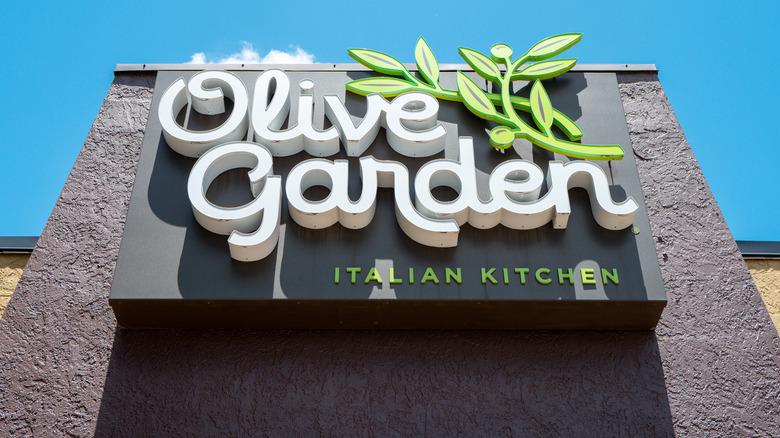You'll Probably Never Catch An Italian Tourist Going To Olive Garden In America, And Here's Why
If you're thinking about taking some visiting Italians to the Olive Garden for some authentic Italian cuisine, think again. It's a well-known fact that Italians are extremely proud of their national cuisine, and rightfully so. Seemingly simple in preparation, authentic Italian food is all about fresh, seasonal ingredients prepared in a way that makes them shine. Unfortunately, that ethos does not translate to the American interpretation of Italian cuisine found in chain restaurants like the Olive Garden.
One hilarious TikTok from user Gabby Donahue sums up the difference between Italian American and Italian cuisine, with a Boston man stunning his Italian waiter with a picture of Olive Garden chicken parm. The waiter is utterly perplexed, shaking his head and stating, "It doesn't exist in Italy. I don't know what it is." How could that be, you might say? In reality, chicken parmesan is not an Italian dish, but an American interpretation of melanzane alla Parmigiana. This fried eggplant dish is a staple in southern Italy and was brought to America by Sicilian immigrants who then substituted the eggplant for chicken, which was more affordable in their new country.
Another Olive Garden staple that would make any Italian wrinkle up their nose is the restaurant's extensive selection of Alfredo pasta dishes. There are an incredible six variations on this dish in the restaurant, which, while invented in Rome, is not something you'll find on many menus in the Old Country. The original pasta Alfredo was created in 1908 and was originally a sort of pasta mixed with butter and parmesan cheese, using pasta water to make it creamy. This is still a typical Italian comfort food dish, and can be quite delicious, but its American iteration, which uses cream to thicken the sauce and adds a protein element, is far from the Italian original.
The big difference between Italian and Italian American food
The addition of heavy cream and protein is a staple of American reinterpretations of classic Italian dishes and is perhaps best exemplified by Olive Garden's chicken and shrimp carbonara. This dish made my carbonara-loving Italian husband raise his eyebrows and shake his head in disbelief, as the recipe not only includes chicken and shrimp — and chicken is usually never eaten with pasta in Italy — but also features the dreaded heavy cream. The only meat that Italian carbonara uses is guanciale, which is cured pork cheek, and the original dish's sauce utilizes only egg yolk, cheese, and pasta water to get its creamy consistency.
So if you expect to impress an Italian companion with Olive Garden's spaghetti and meatballs or stuffed fried ziti pasta, think again. These simply don't exist in the lexicon of Italian cuisine — at least, not how Americans serve them. Meatballs, either with sauce or without, are ordered as a first or second course at meals in Italy, before or after the pasta dish. Combining the pasta and the meatball simply doesn't happen in Italy.
While Olive Garden is certainly not authentic Italian cuisine and may leave the wrong impression on a native Italian, that doesn't mean it's bad. Rather than looking at it as an Italian restaurant, it's best to think of it as an Italian-American restaurant. In the same way that traditional Mexican food is quite different than Tex-Mex cuisine, Italian cuisine has undergone countless variations to suit the American palate and ingredients. So the next time you go to Italy, be prepared for Italian dining habits, and remember that while you won't find your favorite chicken parmesan or spaghetti and meatballs, you'll have the chance to eat authentic Italian food like a local rather than a tourist.

